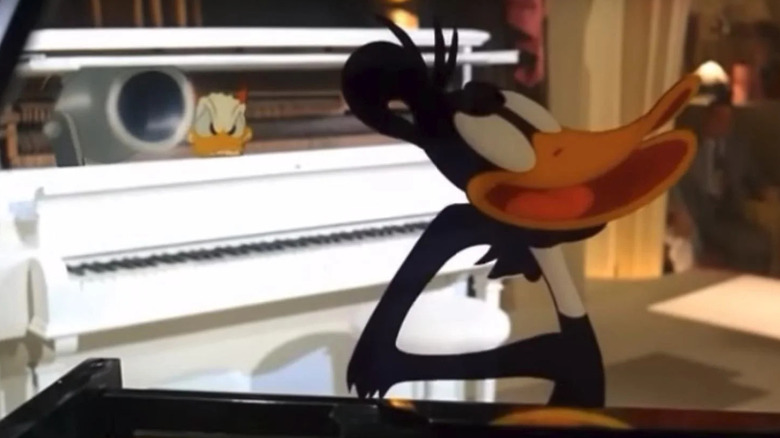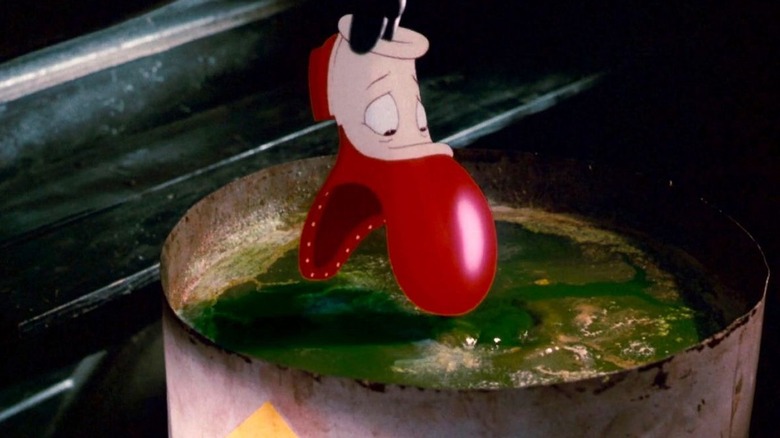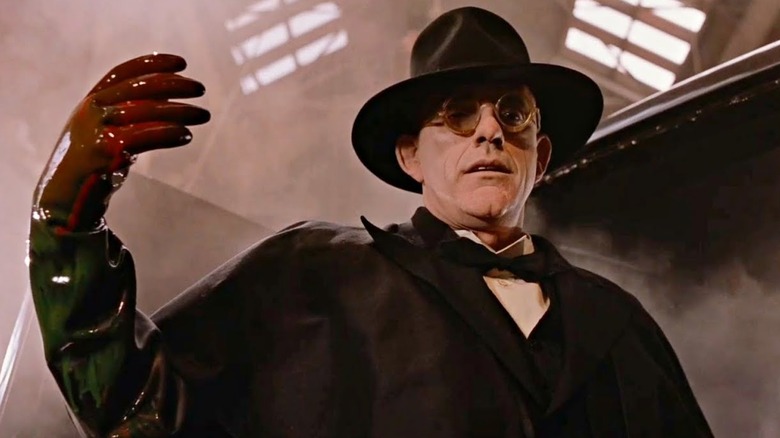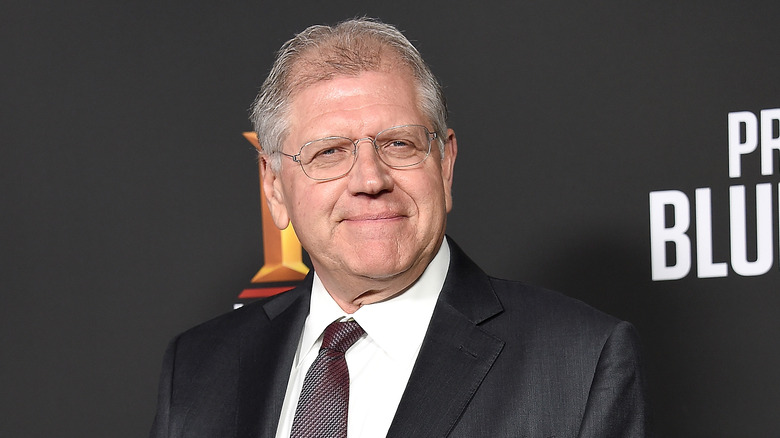The Untold Truth Of Who Framed Roger Rabbit
"Who Framed Roger Rabbit" was one of Disney's saving graces during a time in the company's history that was mired by critically and commercially underwhelming films (via BFI). Mixing elements of a live-action movie with an animated film, "Roger Rabbit" was looked upon as one of the most inventive and original family films of its era.
Set in a fictional universe where humans and cartoon characters live side by side, "Who Framed Roger Rabbit" follows tough-talking private detective Eddie Valiant (Bob Hoskins) as he uncovers a plot to frame a famous toon actor for murder. Mixing in elements of classic noir and taking advantage of its 1940s period setting, "Roger Rabbit" was a deft blend of comedy, action, and mystery that led to rave reviews at the time of its release in 1988.
A box office smash, grossing $351.5 million against a $50.6 million budget (via The Numbers), "Roger Rabbit" went on to win three Academy Awards, and was eventually selected for preservation by the Library of Congress in 2016 for being "culturally, historically, or aesthetically significant." Nowadays, it's credited for renewing interest in the Golden Age of animation, and for ushering in a new era for critically successful Disney animated films.
Despite all its apparent success, there are still some aspects of "Roger Rabbit" that tend to go overlooked by audience members who see the film. From backstage information about the movie's potential stars to the several attempted sequels over the years, here are some of the most interesting bits of trivia surrounding "Who Framed Roger Rabbit."
It's the first and only movie to feature Disney and Warner Bros. cartoons together
Featuring cameos from classic characters like Mickey Mouse, Bugs Bunny, Betty Boop, and numerous others, "Roger Rabbit" is (to date) the only movie to ever feature both Warner Bros. and Disney animated characters in the same film. The process for ensuring that these characters could appear in "Roger Rabbit" was an arduous one on the part of the filmmakers, but ultimately guaranteed the appearance of every famous character shown in the movie.
While Disney Studios saw to the distribution of the film and guaranteed the filmmakers the rights to their characters, "Roger Rabbit" executive producer Steven Spielberg had to negotiate the rights of certain characters from other studios. As part of these negotiations, Spielberg was able to bring Warner Bros. into the fold, with the studio agreeing to allow their characters' appearance in the film for a flat rate of $5,000 per character (via The Hollywood Reporter).
In addition to monetary fees, Warner Bros. also requested several smaller concessions that Spielberg and his team were expected to fulfill in order to use the studio's characters in the movie. In particular, Warner Bros. requested that their characters receive the same amount of screen time as Disney's, or were placed alongside them in several key scenes. To cater to this, the animators placed Daffy Duck in the dueling pianos scene with Donald Duck, had Bugs Bunny appear in the skydiving scene with Mickey, and had Porky Pig appear with Tinkerbell in the movie's closing moments.
Bill Murray was an early choice to play Eddie Valiant
When it came time to cast "Who Framed Roger Rabbit," producer Steven Spielberg and director Robert Zemeckis had a few different people on their mind for the role of disgruntled private eye, Eddie Valiant. After realizing that they couldn't afford their alleged initial choice for the character, Harrison Ford, whose asking price was too expensive for the film's already ballooning budget, they reportedly approached Chevy Chase, who abruptly turned them down.
The filmmakers then settled on Chase's former "Saturday Night Live" castmate, Bill Murray, as their ideal choice for Valiant. Unfortunately, as reported in The Washington Post, the two were unable to get in touch with Murray as the actor "proved impossible to track down," leading them to cast Bob Hoskins in the role instead. According to Zemeckis's audio commentary for the film (available on the DVD), Murray reportedly screamed out loud in public when he eventually learned via a newspaper interview that the filmmakers wanted him, lamenting the lost opportunity.
Also considered for the lead role was Eddie Murphy, who told UPI in 2003 that he turned down the project because he didn't think it could work and would end up a failure — a decision that he regretted, even calling himself "an idiot" for passing on the movie.
Tim Curry was deemed too terrifying for Judge Doom
"Who Framed Roger Rabbit" boasts one of the most terrifying villains ever found in a family film, thanks to Christopher Lloyd's dramatic turn as the sinister Judge Doom. As fantastic as Lloyd is as the demonic judge, he wasn't the first actor the producers had in mind for the role. Like the numerous actors considered for the role of Eddie Valiant, the filmmakers cycled through a variety of stars they thought an ideal fit for Doom.
One of these actors was Tim Curry, the actor behind such antagonists as Pennywise the Dancing Clown in the TV miniseries version of "It" and Dr. Frank-N-Furter in "The Rocky Horror Picture Show." But during the actor's audition for the part, Robert Zemeckis, Steven Spielberg, and Disney executives Jeffrey Katzenberg and Michael Eisner all deemed Curry's portrayal of Doom "too terrifying" for a children's movie (via ArtPublika).
A number of other actors were then considered for the role, including F. Murray Abraham, Michael Keaton, Roddy McDowall, Christopher Lee, and Peter O'Toole. John Cleese also expressed interest in the role, but the filmmakers were worried that audiences wouldn't take him seriously as a threatening villain due to his comedic background in Monty Python. Eventually, Christopher Lloyd was cast, channeling his earlier performance as an adversarial Klingon commander in "Star Trek III: The Search for Spock" for his part in the movie.
The film uses many of the original voice actors behind its cartoon characters
Due to its 1940s historical setting, "Who Framed Roger Rabbit" borrows a lot of inspiration from period-accurate cartoons that were popular among audiences of their day. Disney and Warner Bros. did their best to ensure authenticity when it came to the visual design of the animated characters; as part of the extra attention to detail they paid in the depiction of those characters, Disney also hired many of the same voice actors behind the Warner Bros. and Disney cartoons of prior decades.
For example, animation legend Mel Blanc — the legendary voice behind Warner Bros. characters like Bugs Bunny, Daffy Duck, and Porky Pig — voices many of the characters he is now synonymous with in "Roger Rabbit." Tony Pope (the fourth official voice actor for Goofy), Tony Anselmo (the second and current voice actor for Donald Duck), Wayne Allwine (the third voice actor of Mickey Mouse), and Russi Taylor (the seventh voice actor for Minnie Mouse) similarly reprise their Disney characters for this film.
But most notable among the voice actors is the appearance of Mae Questel, one of the original voice actors for beloved '30s cartoon Betty Boop. Questel had voiced the character from 1931 to 1939, returning to voice Betty after a nearly 50-year hiatus for "Who Framed Roger Rabbit."
One scene set the standard for future Disney animators
A short scene halfway through the film sees a fugitive Roger accidentally handcuff himself to Eddie. With no way to unlock the cuffs and with Roger on the lam for murder, the two head to the bar Dolores works at, hiding in a backroom that was used for bootleggers during Prohibition. Upon entering the room, Eddie bumps his head on a low-hanging lamp, sending it swinging back and forth as he works on trying to saw off the handcuffs binding him and Roger together.
In an impressive bit of authenticity, the animators actually added in the moving shadows cast by Roger as the lamp swings around the room — a detail that only a handful of viewers notice in the film. However, the level of attention the animators paid when crafting the shadows ultimately set a high bar for virtually every Disney animator that followed.
Nowadays, the term "bump the lamp" — as taken from the "Roger Rabbit" scene in question — is used colloquially among Disney employees who go above and beyond when it comes to working out the most minute details for certain scenes in their films. Often, these details will go unnoticed by most viewers, but the extra bit of attention paid to these scenes is seen as adding a good deal more immersion for the finished product.
Why the title avoids an old Hollywood superstition
Like any business, the film industry is made up of long-held beliefs and superstitions that might mar a movie's production from the get-go. One of the most pervasive filmmaking myths that continues to permeate throughout Hollywood to this day is the belief that ending your film with the wrong punctuation mark might doom your film to failure.
In particular, the questioning title is looked upon as a cursed symbol in the filmmaking business, with many movies deliberately avoiding titles that are an interrogative question or end with a question mark. To get around this age-old superstition, the producers of "Roger Rabbit" opted to leave the question mark off the end of the film's title, even though the original novel that the movie is based upon, "Who Censored Roger Rabbit?," ends with one. However, the title is still composed of an interrogative statement, which is, again, a serious faux-pas in the film industry.
The Dip's main ingredients are actually paint removers
As part of his villainous plot to usher in his freeway, Judge Doom utilizes a toxic mixture of various chemicals capable of literally erasing toons from existence. This mixture — dubbed "The Dip" by the Judge — is revealed to be an unholy concoction of turpentine, acetone, and benzene, and is used to horrifying effect when the Judge lowers an adorable anthropomorphic shoe into the mixture, leading the toon to completely and agonizingly vanish.
It may seem a bit overly theatrical for the Judge to use conveniently lethal toxic waste to wipe out his toon adversaries, but the components of The Dip and its effects do have some basis in real life. In actuality, the three named ingredients of The Dip — turpentine, acetone, and benzene — are all commonly-used paint thinners, each of them able to easily remove ink from a surface. The effects of The Dip may be a bit outlandish — thanks especially to its eerie bright green glow — but because of its ability to completely dissolve paint, it makes sense that Doom plans on using it to destroy the entirety of Toontown.
Smaller details about Judge Doom
While "Roger Rabbit" is generally considered a family-friendly movie, there are some more serious moments that can be upsetting for younger viewers. Foremost among these is the appearance of Judge Doom, Christopher Lloyd's demented villain who's later revealed to be behind a vast conspiracy, and the man responsible for Marvin Acme's death. As transformative as Lloyd is in the role, there are some hidden details about Doom's character that make him that much more disquieting an antagonist, and also preemptively clues audiences into the fact that he's actually a toon in disguise.
For example, whenever Doom's eyes are shown on screen, Christopher Lloyd deliberately avoided blinking, both as a way to unsettle viewers and because Doom — as a toon — wouldn't need to blink. "I just felt a toon doesn't have to blink their eyes to remoisten their eyeballs... It makes him even more ominous, more scary, if he's just looking like that," said Lloyd in a Disney+ Q&A on Twitter. More observant viewers may also notice that Doom always avoids physically coming into contact with the Dip, despite the substance being harmless to human beings.
Certain details about Doom's past as a character were also discussed prior to filming. In the 1986 draft of "Roger Rabbit" — then titled "Who Shot Roger Rabbit?" — screenwriters Jeffrey Price and Peter S. Seaman revealed that Doom was intended to be the unseen hunter who killed Bambi's mother in the classic Disney film, "Bambi." In the finished version of the film, the line was cut — although it's worth wondering if the backstory still applies to Doom's character in the movie.
The Pistol Packin' Possum poster foreshadows several key scenes
Early in the film, Eddie meets with prospective employer and media mogul R.K. Maroon (Alan Tilvern) in his office at Maroon Cartoon Studios. As Maroon approaches Eddie with the idea of a job offer, viewers can spot a specific poster for one of Maroon's past productions in the background. This poster — titled "Pistol Packin' Possum" — features a grinning cartoon possum dressed entirely in dark clothing and clutching a comically long pistol.
Each time the poster is shown in the background, the pistol is seen pointing directly at Maroon, the direction of the gun seemingly shifting position depending on where Maroon is in the room. This, of course, foreshadows Maroon's fate in the film's second act, but curiously, the details of the poster seem to more specifically call attention to several later scenes in the movie.
In particular, the long-barreled gun that Maroon's killer uses is the exact same gun shown in the poster. Additionally, the details about the Possum's appearance — such as his all-dark clothing and bright red eyes — may foreshadow the reveal that Judge Doom is actually a toon in disguise. In fact, the similarities between the poster and Doom have even led some fans to theorize that Pistol Packin' Possum and Judge Doom are actually the same character.
The Weasels were originally lampooning the Seven Dwarfs
Judge Doom may be the chief antagonist of "Who Framed Roger Rabbit," but carrying out most of his diabolical orders are the Toon Patrol, a corrupt legion of appointed investigators made up of five cartoon weasel siblings. The visual design and personality of each weasel is drastically different from one another — from the suit-wearing leader, Smarty (David L. Lander), to the gravel-voiced, machine gun-toting Wheezy (June Foray).
In the initial planning stages of "Roger Rabbit," it was intended for the weasels' presence in the film to satirize the Seven Dwarfs from the 1937 Disney film, "Snow White and the Seven Dwarfs," as revealed in the director's commentary for the film. To that end, seven weasels were going to appear in "Roger Rabbit," although two of them (tentatively known as Slimy and Flasher) were eventually omitted. In the 1986 draft of the movie, Judge Doom was also going to have a pet animated vulture named Voltaire. The Judge was also supposed to carry around a suitcase filled with miniature toon kangaroos that would act as his literal "kangaroo court" when it came to passing his judgments. These, too, were eventually cut from the finished film.
Dozens of additional cartoon character cameos were deleted
The main attraction that continues to set "Roger Rabbit" apart as a singularly indelible animated movie is the large amount of Disney and Warner Bros. characters that appear in the film, including Mickey Mouse, Donald Duck, Bugs Bunny, and Daffy Duck. But as massive as the film's cast is, several other famed cartoon characters were initially going to appear in the project as well.
In the third draft of the film's screenplay, a funeral scene was set to take place for Marvin Acme after the Toontown owner's mysterious death. The scripted scene sees Warner Bros.' Foghorn Leghorn deliver Acme's eulogy, with Acme's casket lowered to the ground to the tune of "Pop Goes the Weasel." In the completed storyboards for the sequence, several famed animated characters were shown in attendance, including Tom and Jerry, Casper the Friendly Ghost, and the '40s-era cartoon Superman. Acting as pallbearers were Yosemite Sam, Elmer Fudd, Popeye, Bluto, Goofy, and Felix the Cat.
Though the scene was storyboarded, it was ultimately scrapped after Disney was unable to gain the legal rights for some of the characters' appearances in the film.
The tunnel to Toontown is also in Back to the Future Part II
Shortly after Eddie's confrontation with Maroon at Maroon Cartoon Studios, the private detective chases after Jessica Rabbit in a high-speed pursuit across Los Angeles, stopping only when Jessica enters Toontown via a dark tunnel. Sharp-eyed viewers and super-fans of director Robert Zemeckis's films may be able to recognize this particular tunnel from the 1989 sequel to Zemeckis's previous movie, "Back to the Future."
After the success of "Who Framed Roger Rabbit," Zemeckis returned to this specific tunnel when it came to the climactic chase scene in "Back to the Future II," which sees Marty McFly trying to run away from Biff's souped-up muscle car. In reality, this tunnel is a fairly unremarkable landmark located in Griffith Park. In addition to its appearances in Zemeckis's two films, it was also used earlier in the decade as the entrance to NORAD's command compound in 1983's "WarGames."
Bob Hoskins had to take a year off from acting
Bob Hoskins' turn as the surly, down-on-his-luck private detective at the heart of "Who Framed Roger Rabbit" remains one of the best and most recognized roles of his career. As remarkable as his performance in the film is, Hoskins reported that he suffered some serious mental trauma from his time working on the movie, so much so that he had to take a year off from acting to recuperate.
In interviews following the release of "Roger Rabbit," Hoskins said that, because of the unorthodox nature of the film, he had to habitually imagine he was talking to the animated characters in their scenes together, as they were obviously unable to appear together in person. Having to consistently pretend he was talking to people that weren't there, Hoskins told The Express that he began seeing hallucinations of the movie's animated characters for some time after the film's production had wrapped.
"I think I went a bit mad while working on that. Lost my mind," Hoskins said years later. "The trouble was, I had learned how to hallucinate. If you do that for eight months it becomes hard to get rid of." For the sake of his mental health, Hoskins decided not to appear in another film for some time after "Roger Rabbit," returning to the big screen for 1990's "Heart Condition."
Several sequels have been proposed over the years
Given its critical acclaim, massive financial success at the box office, and popularity among Disney fans in the 1980s, it seemed inevitable that "Who Framed Roger Rabbit" would see a sequel at some point after the film's release. Though a sequel has obviously yet to come to fruition, there have been several attempts to follow up "Roger Rabbit" with another feature-length movie over the years.
In 1989, at the behest of Steven Spielberg, aspiring filmmaker and future "Star Wars" director J.J. Abrams completed an outline for a sequel that was never greenlit into full production. That same year, screenwriter Nat Mauldin wrote a prequel, "Roger Rabbit Two: The Toon Platoon," that would have detailed Roger's early life in the 1940s, his first interactions with Jessica Rabbit, and his service in World War II. This, too, went nowhere.
Several more attempts to produce a sequel were tried over the next few decades, each of them meeting with a disastrous end. Robert Zemeckis has discussed the potential for a "Roger Rabbit" sequel, telling The Telegraph in 2016 that the most recent script he read was "excellent." However, the director also said that the chances were "slim" that Disney would approve the film's production, as it doesn't necessarily fit into the current Disney climate. "I don't know where [the sequel] fits in their universe," Zemeckis told Yahoo Movies UK in 2018. "There's no princess in it, so I don't know where that would be. There's a wonderful script sitting at Disney that is really good, but I don't think it's on their radar."














